Sweet Treats: Exploring Chinese Desserts
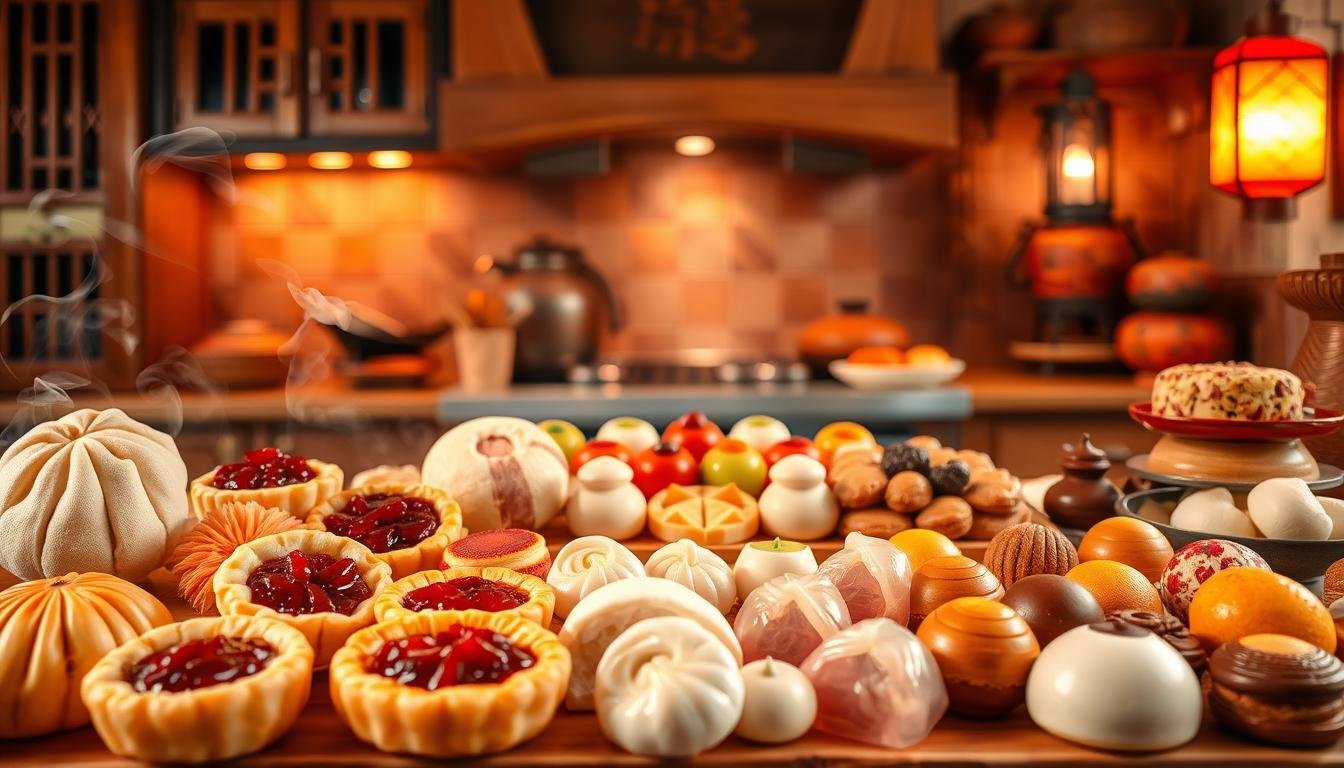
Ever wondered why Chinese desserts are both traditional and versatile? They mix many flavors and forms.
Mooncakes bring delicate sweetness during the Mid-Autumn Festival. Tangyuan offers gooey delight when shared with family. These Chinese desserts bring joy with every bite. They are part of daily life and connect us to our heritage.
We’ll look at traditional desserts, their unique ingredients, and modern versions. Whether making them or just learning, it will be fun and tasty. This journey into Chinese sweets will be enlightening and delicious.
We will discover the stories and tastes of China’s beloved traditional desserts. Let’s see why these sweets have won hearts for so long.
Introduction to Chinese Desserts
Chinese cuisine is famous for its deep flavors and cultural depth. Desserts have a big role in this. They are not just for sweet cravings, they mean something special and are key to many celebrations.
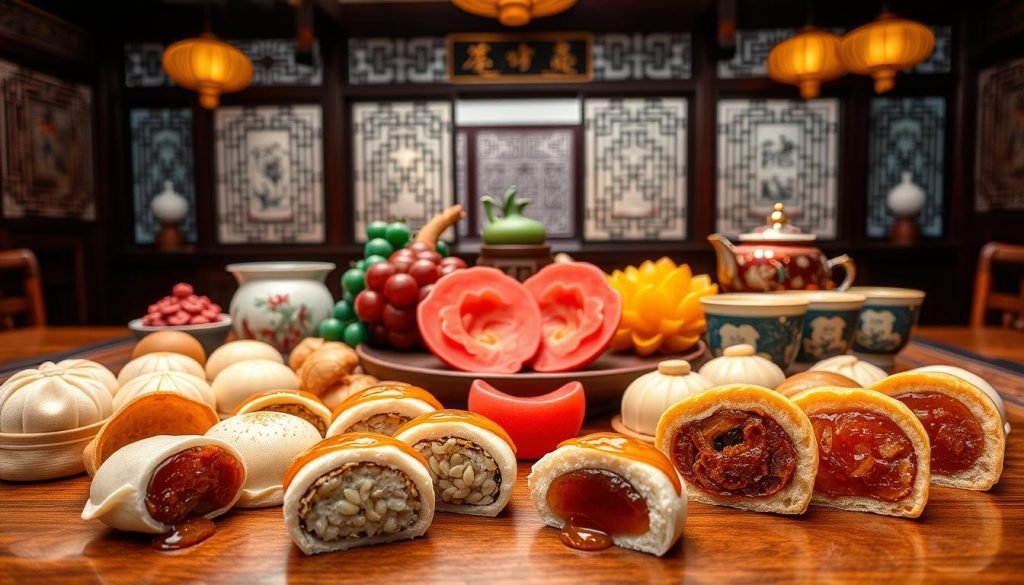
The Role of Desserts in Chinese Culture
Desserts are more than the last course in a Chinese meal. They often mean good luck, joy, and bring families together. For example, mooncakes are important during the Mid-Autumn Festival. They stand for unity and wealth. Tangyuan, sweet rice balls, are eaten during the Lantern Festival in the south. They symbolize family togetherness.
Some desserts, like red bean soup, are loved as both hot and cold treats in Taiwan. These sweets connect people, keep traditions alive, and share good wishes.
The Ingredients That Make Chinese Desserts Unique
Chinese sweets are special because of their diverse and meaningful ingredients. They often use red bean paste, sticky rice, and jujube. Glutinous rice is valued for being sticky and chewy. Red bean paste gives a gentle sweetness to many snacks.
Things like agar for jelly desserts and lotus seed paste for flavor show the tradition in Chinese sweets. These ingredients make the taste better and tie the desserts to culture and health. This makes them liked by more people.
| Ingredient | Significance |
|---|---|
| Red Bean Paste | Offers a mild sweetness; symbolizes luck and fortune. |
| Glutinous Rice | Sticky and chewy texture; gluten-free. |
| Jujube | Commonly used for its medicinal properties and symbolic value. |
| Agar | Used to set jelly desserts; provides a unique texture. |
| Lotus Seed Paste | Traditional mooncake filling; symbolizes purity and harmony. |
Popular Traditional Chinese Desserts
Diving into Chinese sweets, we find amazing treats. Each dessert is culturally important. Let’s look at Mooncakes, Tangyuan, and Egg Tarts.
Mooncakes: A Time-Honored Treat
Mooncakes are a key part of the Mid-Autumn Festival. Families gather to share these pastries. They have lotus seed paste and salted egg yolks inside.
The making of Mooncakes is complex. They need a special stamp for their patterns. With many types and new designs, they symbolize bounty and wealth.
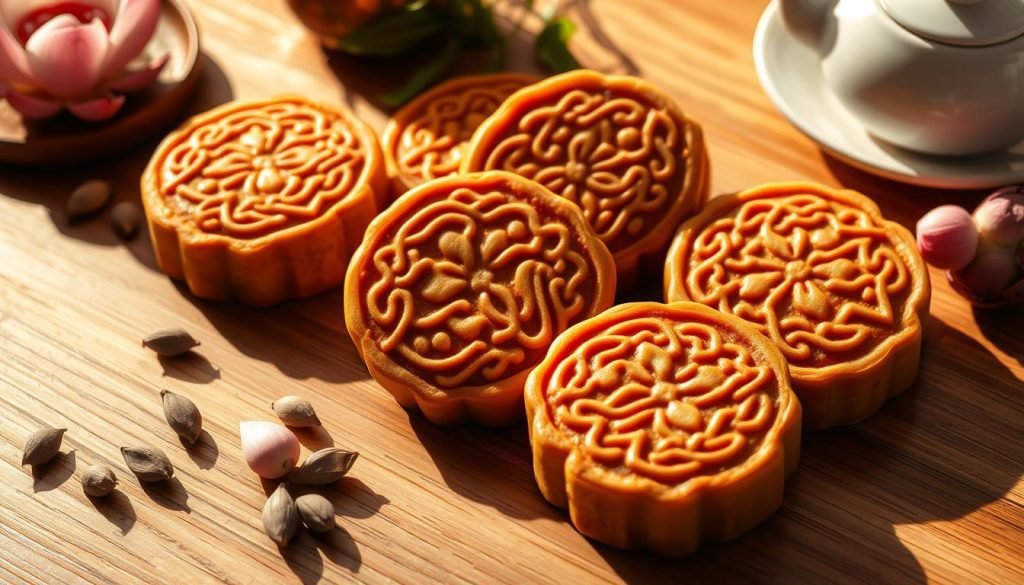
Tangyuan: Sweet Glutinous Rice Balls
Tangyuan is crucial for the Lantern Festival. This festival is 15 days after the New Year. These balls mean family togetherness and come in sweet syrup.
Making Tangyuan uses sticky rice flour for a soft texture. They really show what Chinese desserts are all about.
Egg Tarts: A Fusion of East and West
The British in Hong Kong brought Egg Tarts. They mix Eastern and Western tastes well. These tarts have a crispy crust and soft custard.
They are a hit at Chinese buffets and dim sum places. There are two kinds: Hong Kong-style and Macau-style. This dessert shows how Chinese sweets mix different culinary styles.
Mooncakes, Tangyuan, and Egg Tarts blend tradition and new ideas. They delight us and teach about China’s culture and food evolution.
Regional Variations in Chinese Sweets
Chinese cuisine takes you on an amazing journey through its desserts. Each region offers something distinct. From Northern China’s sweet buns to Southern China’s fruit desserts, there’s a lot to try.
Northern vs. Southern Dessert Styles
In the North, people love pastries and hearty sweets. Sweet buns, or baozi, are very popular. They are often stuffed with red bean paste or sweet black sesame. In the South, desserts are lighter and fruit-based. Mango pudding and coconut milk jelly are favorites there. They offer a fresh change from the North’s heavier treats.
Unique Flavors from Various Provinces
The diversity of desserts across China is amazing. It shows the rich food traditions of each place. Here are some examples:
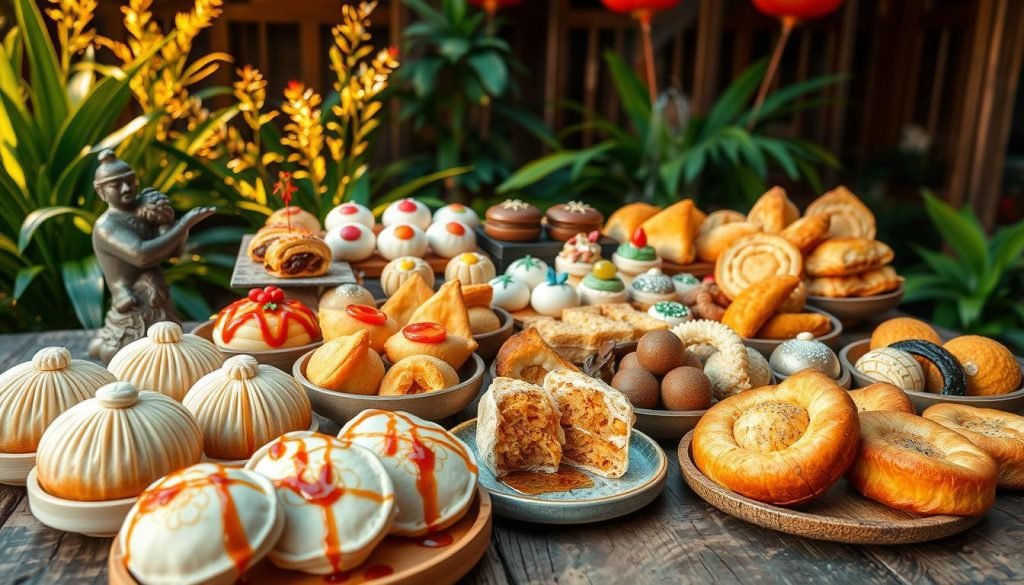
| Region | Popular Desserts | Unique Ingredients |
|---|---|---|
| Sichuan | Sachima, spicy pastries | Honey, glutinous rice, sesame seeds |
| Guangdong | Tongsui (sweet soups) | Mango, pomelo, sweet potato |
| Beijing | Nian Gao (sticky rice cake) | Glutinous rice, lotus seed paste |
| Shanghai | Sweet Osmanthus Rice Cake | Osmanthus flowers, glutinous rice |
| Hubei | Douhua (soft tofu pudding) | Tofu, brown sugar syrup |
| Liaoning | Almond Jelly | Almond extract, apricot kernels |
Gansu and Hangzhou add new tastes to Chinese sweets. From the spicy flavor of Sichuan’s Sachima to Guangdong’s sweet tongsui. Each province adds its own unique touch.
Modern Takes on Classic Chinese Desserts
In recent years, chefs have been changing old Chinese sweets. They use new ingredients and ways to make them. This trend highlights how modern Chinese desserts combine tradition with new tastes.
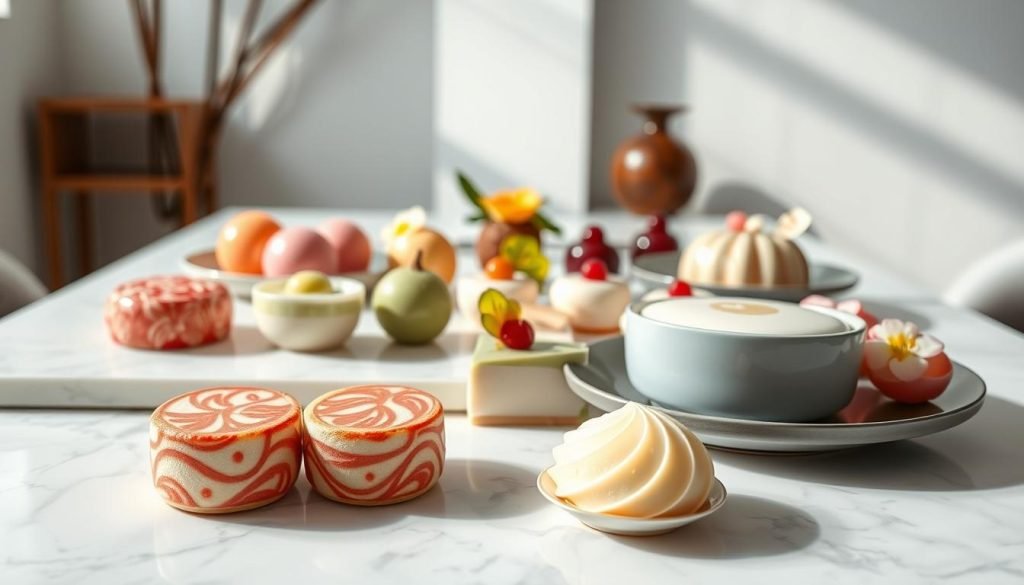
Creative Twists on Traditional Recipes
Sweets like Ang Ku Kueh and Tau Sar Piah are getting a makeover. Ang Ku Kueh, once filled with red bean paste or peanuts, now has hazelnut, yam, and more. Tau Sar Piah is also changing. It adds new tastes like Coffee, Durian, and Green Tea. These changes mix the old with the new, attracting more people.
Fusion Desserts: Merging Cultures
Fusion desserts mix different food traditions. They show the tasty results of this blend. Green tea-flavored mooncakes and chocolate sesame balls are examples. They mix East Asian and Western tastes. Chef Lucas Sin made Tanghulu easy to make, showing it on TikTok. Soya beancurd has evolved too. It used to be simple, but now it has many toppings. These changes show how modern Chinese desserts are influenced by foods from around the world.
| Traditional Dessert | Modern Twist | Delivery Options |
|---|---|---|
| Ang Ku Kueh | Hazelnut, Yam, Pistachio | Free with $96 order from Ang Ku Kueh Hut |
| Tau Sar Piah | Coffee, Durian, Pineapple, Green Tea | Free with $200 order from 603 Tau Sar Piah |
| Soya Beancurd | Attap Seeds, Longan, Pearls, Grass Jelly | No minimum order from House of Soya Beans |
Essential Ingredients in Chinese Desserts
Chinese desserts are special because of their unique parts. Ingredients like red bean paste and lotus seeds are crucial. They bring magic to the food. Knowing about the ingredients in Chinese desserts makes these dishes more enjoyable.

Sweeteners: From Sugar to Red Bean Paste
Sweeteners add just enough sweet touch to Chinese desserts. They make sure the main flavors shine through. Traditional desserts, called 糖水 (tong-sui) or “sugar water”, focus on being simple. There are many favorite sweeteners.
- White Sugar: It’s used a lot, making desserts sweet and tasty.
- Brown Sugar: Common in Hong Kong for tofu pudding toppings. It tastes like molasses.
- Red Bean Paste: Found in many desserts, it’s creamy and sweet.
- Ginger Syrup: Adds warmth and spice to tofu pudding.
| Sweetener | Common Desserts |
|---|---|
| White Sugar | Egg tarts, almond jelly |
| Brown Sugar | Tofu pudding, pumpkin pancakes |
| Red Bean Paste | Red bean buns, tangyuan |
| Ginger Syrup | Tofu pudding, sweet soups |
The Importance of Textures and Flavors
Texture matters as much as taste in Chinese sweets. It makes eating them a joy. Many ingredients help achieve this balance.
- Sticky Rice: Essential for treats like Tangyuan, offering a chewy feel.
- Lotus Seeds: Added to soups and pastry fillings for tenderness and a mild sweet taste.
- Tofu Skin: Found in dishes like tofu skin & pearl barley soup. It adds a unique texture.
- Sweet Potato: Common in sweet soups, it brings a smooth, comforting texture.
Using these ingredients lets you make traditional Chinese desserts with the right feel and taste.
Different pastes like black sesame and almond add unique flavors. Desserts like red bean soup have their special tastes. Each dessert’s ingredients are carefully chosen. This balance is key for an authentic experience.
Tips for Making Chinese Desserts at Home
Making Chinese desserts at home is fun. You get to try different flavors and textures. With many recipes to choose from, you’ll find something you like. Here are some tips to become great at making Chinese desserts.
Key Techniques for Perfecting Your Desserts
Learning key techniques is essential to making Chinese desserts well. Getting the ingredient amounts right is very important. For example, the dough for Tang Yuan should be smooth but not sticky. Cooking times matter too. Overcooking Tangyuan can ruin their texture.
Try making desserts ahead of time for better taste. Some desserts taste better after being in the fridge for a few days. Mooncakes and pineapple pastries are examples of this. Storing them properly makes them taste better.
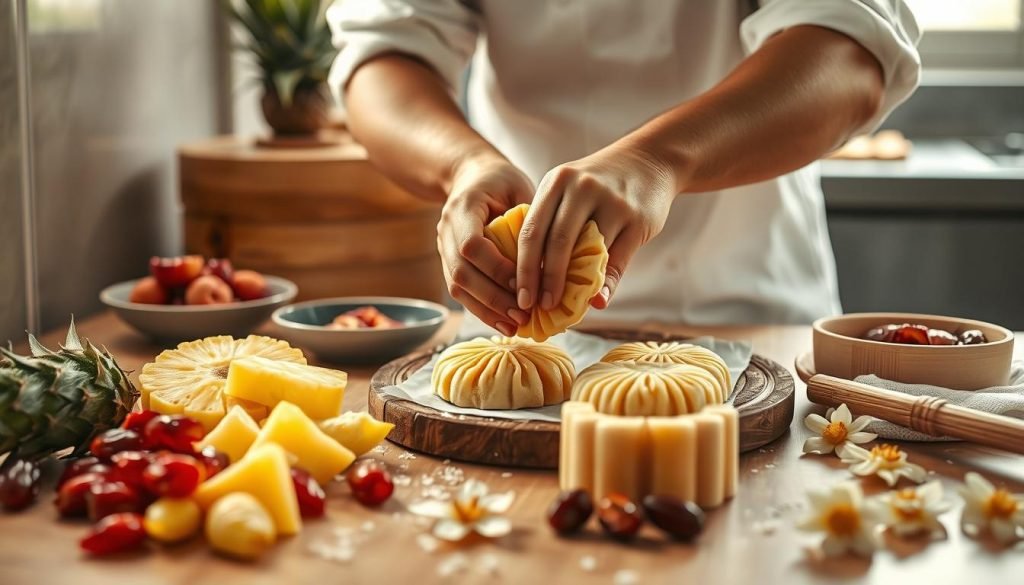
Common Mistakes to Avoid
Even skilled cooks can make mistakes when making Chinese desserts. Don’t use the wrong ingredients. For Tang Yuan, don’t swap glutinous rice flour with regular rice flour. This changes the texture completely.
Getting the oil temperature right is also crucial. Fried dough sticks need oil at about 375°F. Banana fritters fry best at around 350°F. The wrong temperature can cause burning or uneven cooking.
Don’t open the lid too early when simmering dishes like coconut papaya rice. This keeps the cooking just right. Keep these tips in mind to make tasty Chinese desserts.
Where to Find Authentic Chinese Desserts
Finding authentic Chinese sweets can make your food journey exciting. You can check out local Chinese bakeries for traditional flavors. Or, if you like things easy, try online dessert shops. Both have lots of options to fix your cravings.
Local Bakeries and Restaurants to Explore
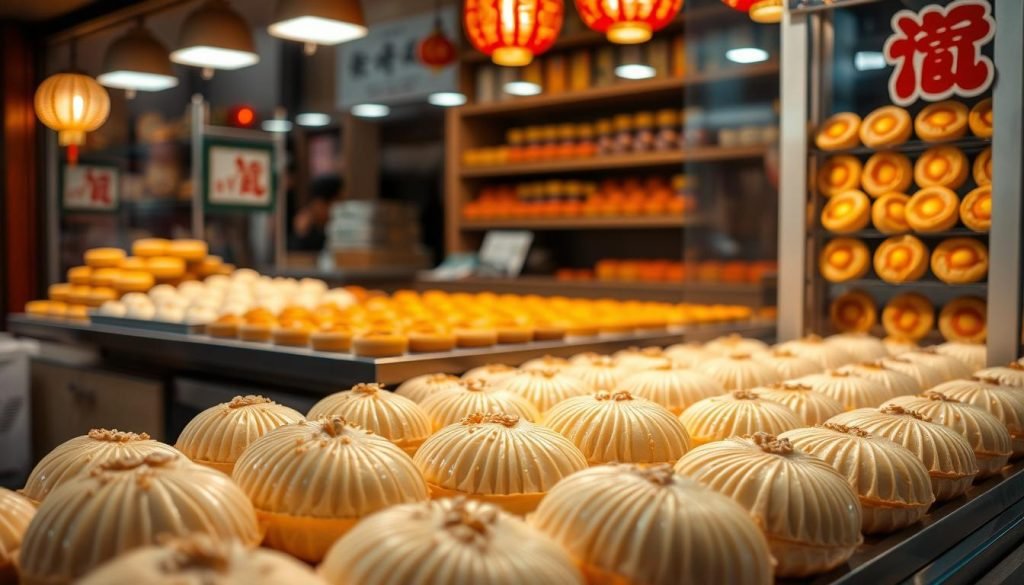
Chinese bakeries are filled with many tasty sweets. They show how rich and varied Chinese food is. For example, Fuhuazhai in Beijing is famous for its mooncakes. They are filled with nuts, seeds, and more. This place is special because it’s not like fast-food places. It gives you a taste of the past.
Another sweet, Yundoujuan, is not too sweet. It’s perfect if you like things less sugary.
Before the mid-autumn festival, everyone wants mooncakes. But, the places where they sell them aren’t too crowded. So, you can enjoy your sweets in peace. Favorite mooncakes in Beijing include Zilaibai and Zilaihong.
Online Options for Purchasing
If you can’t go to local places, online shops are great for finding Chinese sweets. They have so much to choose from, all from your home. You can even find special diet options, like vegan and gluten-free.
Online shops let you have delicious Chinese sweets no matter where you are. Try moon tarts or almond cookies from these sites. It’s super easy to get these yummy treats today. This shows how much everyone loves Chinese desserts all over the world.
Conclusion: Enjoying the Sweet Side of Chinese Culture
Exploring Chinese desserts is more than just tasting something sweet. It lets you connect with the deep traditions of Chinese dessert culture. Desserts like nian gao symbolize hope and success for the Lunar New Year. Tangyuan shows the importance of family. Through these sweets, you get to see the many traditions of China.
Embracing the Diversity of Chinese Desserts
Learning about Chinese desserts shows you a world full of different flavors and styles. You’ll find simple treats like Japanese mochi and also complex ones like Korean patbingsu. These desserts are not just tasty. They tell important stories about where they come from. Trying these desserts helps you appreciate the special nature of Chinese sweets and others.
Encouragement to Try Making Your Own Treats
Have you thought about making Chinese desserts yourself? It’s not as hard as it seems! You can start with nian gao. It only needs six easy ingredients and takes about 30-40 minutes to bake. This recipe is good for vegans and doesn’t have gluten. Plus, it’s full of meaning. Thanks to modern tools, making Asian desserts at home is quicker. So, why not try? Making your own Chinese desserts is a fun way to bring culture into your kitchen.